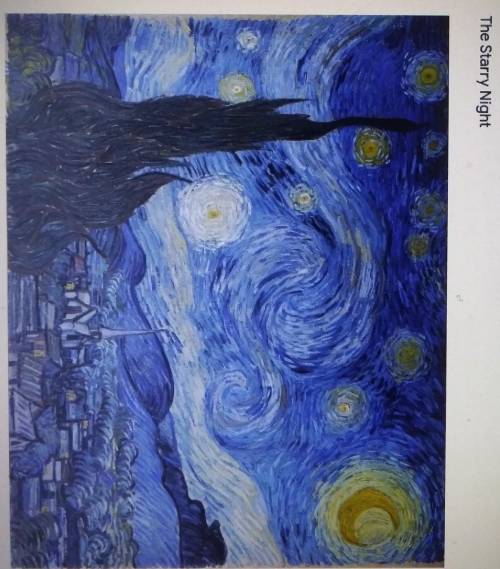We grow accustomed to the Dark —

English, 05.05.2020 10:07 PONBallfordM89
“We Grow Accustomed to the Dark” Emily Dickinson
We grow accustomed to the Dark —
When light is put away —
As when the Neighbor holds the Lamp
To witness her Goodbye —
A Moment — We uncertain step
For newness of the night —
Then — fit our Vision to the Dark —
And meet the Road — erect —
And so of larger — Darknesses —
Those Evenings of the Brain —
When not a Moon disclose a sign —
Or Star — come out — within
The Bravest — grope a little —
And sometimes hit a Tree
Directly in the Forehead —
But as they learn to see —
Either the Darkness alters —
Or something in the sight
Adjusts itself to Midnight —
And Life steps almost straight.
1. Compare and contrast how both Vincent van Gogh's painting The Starry Night and Emily Dickinson's poem "We Grow Accustomed to the Dark" treat the subjects of light and darkness. Be sure to explain how both artists rely on a tension between light and darkness in these works/mediums. (attached is the painting so you may refer back as needed)


Answers: 1
Another question on English


English, 22.06.2019 03:40
Which organizational method does your reading material suggest is particularlyuseful when writing about a place? of importancecause → effect
Answers: 3

English, 22.06.2019 04:00
Tori is writing a literary analysis of the novel little women. read the following claim statement she wrote about the story. in little women, louisa may alcott uses figurative language to readers understand the feelings and experiences of the central characters. which quote from the story can tori use as evidence to support her claim? a. “she knew it very well, for it was that beautiful old story of the best life ever lived, and jo felt that it was a true guidebook for any pilgrim going on a long journey.” b. “‘and so nice of annie moffat not to forget her promise. a whole fortnight of fun will be regularly splendid,’ replied jo, looking like a windmill as she folded skirts with her long arms.” c. “‘rather a pleasant year on the whole! ’ said meg, smiling at the fire, and congratulating herself on having treated mr. brooke with dignity.” d. “‘what are you thinking of, beth? ’ asked jo, when amy had her father and told about her ring.”
Answers: 1

English, 22.06.2019 04:30
In order really to hate white people, one has to blot so much out of the mind — and the heart — that this hatred itself becomes an exhausting and self-destructive pose. but this does not mean, on the other hand, that love comes easily: the white world is too powerful, too complacent, too ready with gratuitous humiliation, and, above all, too ignorant and too innocent for that.which sentence best explains how the use of parallelism in the excerpt supports baldwin's purpose? a. it proves baldwin's central idea by highlighting the obvious.b. it emphasizes the problems that prevent one from loving the white world.c. it explains why the white world is unable to replace hate with love.d. it enumerates the many ways of dealing with the white world.
Answers: 1
You know the right answer?
“We Grow Accustomed to the Dark” Emily Dickinson
We grow accustomed to the Dark —
We grow accustomed to the Dark —
Questions

Chemistry, 28.09.2020 17:01

Mathematics, 28.09.2020 17:01


Social Studies, 28.09.2020 17:01




Mathematics, 28.09.2020 17:01

English, 28.09.2020 17:01


Chemistry, 28.09.2020 17:01



Mathematics, 28.09.2020 17:01

Physics, 28.09.2020 17:01

Biology, 28.09.2020 17:01

Mathematics, 28.09.2020 17:01

History, 28.09.2020 17:01




